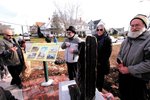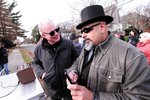By EMMA BARTLETT
David Goldenberg’s idea started with a pothole. Well, the idea really started with what was inside the pothole when Goldenberg peered in and discovered old …
This item is available in full to subscribers.
We have recently launched a new and improved website. To continue reading, you will need to either log into your subscriber account, or purchase a new subscription.
If you are a current print subscriber, you can set up a free website account by clicking here.
Otherwise, click here to view your options for subscribing.
Please log in to continue |
|




David Goldenberg’s idea started with a pothole. Well, the idea really started with what was inside the pothole when Goldenberg peered in and discovered old streetcar tracks. The rails, located on Narragansett Boulevard near Sefton Drive, mark the end of the trolley line that used to run from Edgewood to Providence.
“120 years ago if you were standing at this corner starting at 5:56 a.m., a street car would have been leaving for Providence and there would have been one coming every 10 minutes. That’s pretty extraordinary to think about,” said Goldenberg Sunday afternoon at the corner of Narragansett Boulevard and Sefton Drive.
Goldenberg was joined by the Edgewood Waterfront Preservation Association (EWPA), community members and local officials on Dec. 4 to celebrate the unveiling of the new End of Line sculpture and marker that memorializes the significance of Edgewood’s trolley roots. The sculpture, created by Goldenberg’s artist friend David Karoff, consists of three welded pieces of streetcar tracks. Goldenberg obtained the tracks from Cranston's Department of Public Works when the city began repaving Narragansett Boulevard in 2017. At the time, Goldenberg had the vague idea of a friend creating a sculpture from the remains. Today, the site’s historic marker explains how trolleys shaped Edgewood’s neighborhood and provides a QR code that links individuals to a supplementary film that Goldenberg created.
In a Monday interview, EWPA President Barbara Rubine said Goldenberg approached EWPA when he was searching for a location to set the sculpture upon completion. Originally, he thought it could go by the waterfront but, the more Rubine learned about the project, it occurred to her that there was a right of way located at the actual end of the line. Goldenberg and EWPA explored getting city permission to put the sculpture at the corner of Sefton Drive and Narragansett Boulevard and contacted the neighbors who bordered the proposed location.
Sefton Drive resident Gary Leveille, who lives next to the sculpture, said Rubine approached him a year ago about having a sculpture near the corner of their property. Leveille was skeptical at first, but when EWPA showed how it would enhance the corner, the organization worked with the neighbor to make sure to put this together.
Funding for the historic marker comes from a $1,300 grant that was obtained with the Cranston Historical Society’s assistance. This past summer the marker and sculpture’s base were installed. Goldenberg said the city’s mason, Dennis Conte, did some work and completed the work on his own time. Since this area is a walkable area, Goldenberg said many individuals have inquired about the project since work began during the summertime.
Rubine said community members were thrilled when they found out about the project. EWPA and Goldenberg spread word about the End of Line project by posting a trailer of Goldenberg’s film about the trolley line on EWPA’s website and promoting fundraising. Goldenberg also posted signs of the project on telephone poles, in local businesses and EWPA had a dispenser at the sculpture's site that gave information on the project.
Rubine said the project is impactful in multiple ways. For starters, the marker and sculpture bring history to the attention of people who frequent the area and connect them with the neighborhood’s early history of mass transportation in Edgewood. Second, the project brings art into the neighborhood in a creative and interesting way.
The majority of funding came from exterior work and landscaping that came through fundraising efforts of the Edgewood Waterfront Preservation Association. Goldenberg said overall, the project cost roughly $5,000.
Rubine highlighted the number of ways people participated in the project’s process. She said a lot of the monetary and physical contributions came from people in the neighborhood. Families donated old bricks and the city provided gravel and a mason for the project. She said the old bricks made the sculpture more authentic looking since they both have an old history. She thanked the neighbors, city, community members who helped make this possible.
While this project was a little different from what the work EWPA has completed in the past, End of Line fits into the organization’s mission to educate the community about the waterfront and preserve and protect it.
At Sunday’s unveiling, former Warwick Mayor and president and CEO of the Rhode Island Public Transit Authority, Scott Avedisian talked of circular occurrences and how public transportation is returning to electrification with electric buses. He noted that the recharging station for the buses, soon to be built, won't be far from where trollies first operated and that we have come "full circle."
Mayor Ken Hopkins jokingly pointed out that as a Republican he was surprised to be invited to speak in Edgewood until he read it was for an event celebrating "the end of the line." Could that be a reference to his political career, he questioned to laughs.
History of the streetcar suburb
Through research, Goldenberg found that beginning in 1868, a horse-drawn trolley ran between Market Square in Providence and the bridge in Pawtuxet Village. At the time, there were no more than 50 dwellings in Edgewood. Over the next five decades, the streetcar would define the neighborhood’s growth. The film shares how individuals would stop by to visit the shoreline, yacht clubs and Roger Williams Park. The ride from Providence’s Market Square to the Rhodes on the Pawtuxet stop took 52 minutes. Trolleys for the Edgewood line were stored and serviced in car barns on Broad Street, Elmwood Avenue, and Cranston Street.
Street car service expanded throughout the state in the early 20th century and 1908 statistics from the Rhode Island Railroad Commissioner revealed there were 10 street railway charters conducting business in the state. There were 389 miles of roadway and, in that year, 87 million passengers rode the trolley and 3,149 were employed by the railway charters. These companies owned 938 motor cars, 84 freight cars and 81 other cars. Freight cars carried coal, lumber and other goods, while some were freight/passenger cars and regular trolleys carried mail and newspapers.
Annual ridership peaked at 154 million in 1923 followed by a decline due to automobile ownership and the effects of the Depression. Between 1926 and 1936 trolley ridership in the Providence metropolitan area declined over 30 percent.
Goldenberg’s film shares that housing construction took off in 1892 with the electrification of the Broad Street line and the Eddy Street – Narragansett Boulevard Line in 1896; most of the houses were built between 1892 and 1930.
The film also explains that the Providence Journal produced a guide of Union Railroad Trolley Trips written by Mariana Tallman which offers advice on what trolleys to take and tips to ensure your hat does not fly off during your ride.
The Edgewood tracks were abandoned in 1939 as society converted to electricity powered trackless trolleys. At this time, wires extended to Stillhouse Cove where the new trackless trolley could make a turn. Prior to this, when the streetcar arrived at the end of the line at Sefton Drive, the motormen would reverse the seats and power pole for the trip back. The trolley’s demise came in the 1950s and Goldenberg said it was partly due to an anti-trust initiative that forced transport companies to divest their ownership of power plants.
EWPA is still working to raise money to fund the project. Contributions are tax deductible and can be sent to EWPA at 1438 Narragansett Blvd., Cranston, RI, 02905. Checks can be marked trolley memorial. Individuals can also donate online at www.stillhousecove.org/end-of-the-line/.
Comments
No comments on this item Please log in to comment by clicking here